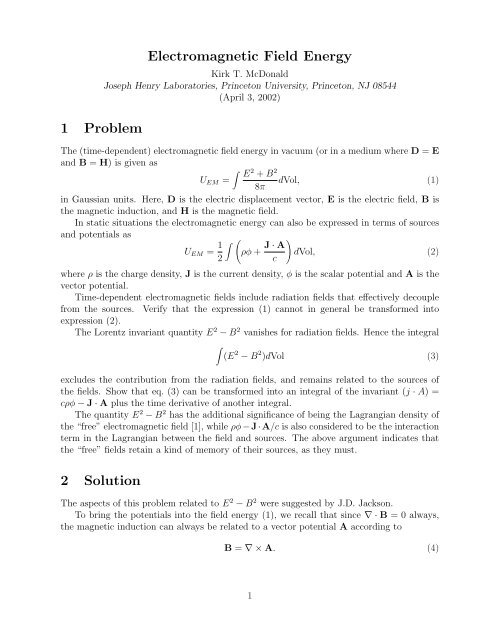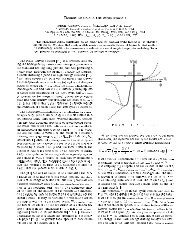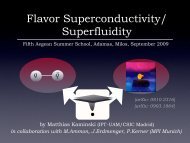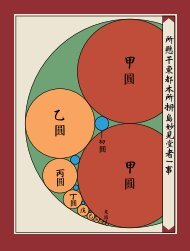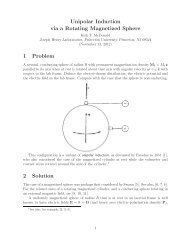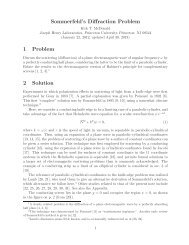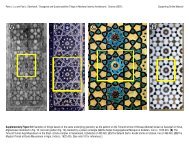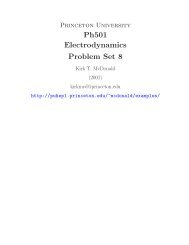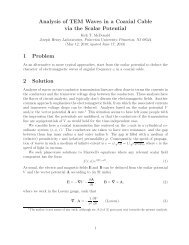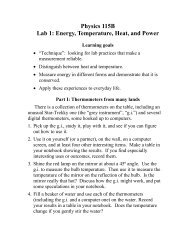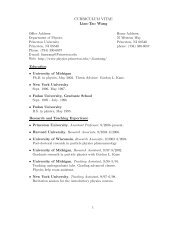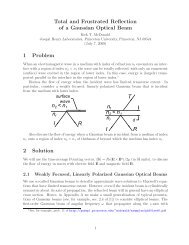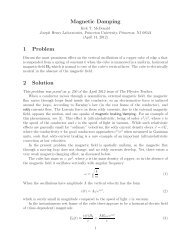Electromagnetic Field Energy - Princeton University
Electromagnetic Field Energy - Princeton University
Electromagnetic Field Energy - Princeton University
You also want an ePaper? Increase the reach of your titles
YUMPU automatically turns print PDFs into web optimized ePapers that Google loves.
1 Problem<br />
<strong>Electromagnetic</strong> <strong>Field</strong> <strong>Energy</strong><br />
Kirk T. McDonald<br />
Joseph Henry Laboratories, <strong>Princeton</strong> <strong>University</strong>, <strong>Princeton</strong>, NJ 08544<br />
(April 3, 2002)<br />
The (time-dependent) electromagnetic field energy in vacuum (or in a medium where D = E<br />
and B = H) is given as<br />
∫ E 2 + B 2<br />
U EM =<br />
dVol, (1)<br />
8π<br />
in Gaussian units. Here, D is the electric displacement vector, E is the electric field, B is<br />
the magnetic induction, and H is the magnetic field.<br />
In static situations the electromagnetic energy can also be expressed in terms of sources<br />
and potentials as<br />
U EM = 1 ∫ ( ρφ + J · A )<br />
dVol, (2)<br />
2<br />
c<br />
where ρ is the charge density, J is the current density, φ is the scalar potential and A is the<br />
vector potential.<br />
Time-dependent electromagnetic fields include radiation fields that effectively decouple<br />
from the sources. Verify that the expression (1) cannot in general be transformed into<br />
expression (2).<br />
The Lorentz invariant quantity E 2 − B 2 vanishes for radiation fields. Hence the integral<br />
∫<br />
(E 2 − B 2 )dVol (3)<br />
excludes the contribution from the radiation fields, and remains related to the sources of<br />
the fields. Show that eq. (3) can be transformed into an integral of the invariant (j · A) =<br />
cρφ − J · A plus the time derivative of another integral.<br />
The quantity E 2 − B 2 has the additional significance of being the Lagrangian density of<br />
the “free” electromagnetic field [1], while ρφ − J · A/c is also considered to be the interaction<br />
term in the Lagrangian between the field and sources. The above argument indicates that<br />
the “free” fields retain a kind of memory of their sources, as they must.<br />
2 Solution<br />
The aspects of this problem related to E 2 − B 2 were suggested by J.D. Jackson.<br />
To bring the potentials into the field energy (1), we recall that since ∇ · B = 0 always,<br />
the magnetic induction can always be related to a vector potential A according to<br />
B = ∇ × A. (4)<br />
1
Faraday’s law can therefore be written as<br />
∇ × E = − 1 c<br />
∂B<br />
∂t = −∇ × 1 ∂A<br />
c ∂t . (5)<br />
Thus, the curl of the quantity<br />
E + 1 ∂A<br />
(6)<br />
c ∂t<br />
vanishes, which means that this quantity can be expressed as −∇φ where φ is a scalar<br />
potential. That is, the electric field can be written in terms of potentials as<br />
E = −∇φ − 1 c<br />
Inserting expression (7) into the electric part of eq. (1), we find<br />
U E = 1 ∫<br />
8π<br />
= − 1<br />
8π<br />
= − 1<br />
8π<br />
using the Maxwell equation,<br />
∂A<br />
∂t . (7)<br />
E 2 dVol = − 1 ∫<br />
E · ∇φ dVol − 1 ∫<br />
E · ∂A<br />
8π<br />
8πc ∂t dVol<br />
∫<br />
∇ · (φE) dVol + 1 ∫<br />
φ∇ · E dVol − 1 ∫<br />
8π<br />
8πc<br />
∫<br />
φD · dS + 1 ∫<br />
ρφ dVol − 1 ∫<br />
2<br />
8πc<br />
Likewise, the magnetic energy can be written<br />
U M = 1 ∫<br />
8π<br />
= − 1<br />
8π<br />
= − 1<br />
8π<br />
ɛE · ∂A<br />
∂t dVol<br />
E · ∂A dVol (8)<br />
∂t<br />
∇ · E = 4πρ. (9)<br />
B 2 dVol = 1 ∫<br />
B · ∇ × A dVol<br />
8π<br />
∫<br />
∇ · B × A dVol + 1 ∫<br />
A · ∇ × B dVol<br />
8π<br />
∫<br />
B × A · dS + 1 ∫<br />
J · A dVol + 1 ∫<br />
2c<br />
8πc<br />
A · ∂E dVol, (10)<br />
∂t<br />
using the Maxwell equation<br />
∇ × B = 4π c J + 1 ∂E<br />
c ∂t . (11)<br />
For charges and current that occupy only a finite volume, the surface integrals in eqs. (8)<br />
and (10) go to zero as the surface becomes large. To see this, first suppose that there are no<br />
wave fields, so the potentials fall off at least as fast as 1/r, and the quasistatic fields fall off<br />
at least as fast as 1/r 2 . Since the surface area increases as r 2 , the surface integrals fall off as<br />
1/r and can be neglected. If there are wave fields, then for large enough r, the leading terms<br />
of A, E and B are all orthogonal to the surface vector dS and again the surface integrals can<br />
be neglected. An alternative justification for neglecting these integrals is given by Stratton<br />
[2].<br />
Thus, the electromagnetic field energy can be written as<br />
U EM = U E + U M = 1 2<br />
∫ ( ρφ + J · A<br />
c<br />
)<br />
dVol + 1 ∫ ( A · ∂E<br />
8πc ∂t − E · ∂A )<br />
dVol. (12)<br />
∂t<br />
2
The second integral in eq. (12) can be transformed in various ways, but in general it is<br />
nonzero. The time-dependent electromagnetic energy (1) includes additional physical effects,<br />
the radiation fields, not accounted for in the expression (2).<br />
The difference between the electric and the magnetic energies, in which contributions<br />
from radiation fields cancel, is<br />
∫ E 2 − B 2<br />
U E − U M =<br />
dVol<br />
8π<br />
= 1 ∫ ( ρφ − J · A )<br />
dVol − 1 ∫ ( A · ∂E<br />
2<br />
c<br />
8πc ∂t + E · ∂A )<br />
dVol<br />
∂t<br />
= 1 ∫<br />
(j · A) dVol − 1 ∫<br />
d<br />
A · E dVol, (13)<br />
2c<br />
8πc dt<br />
where j = (cρ, J) is the 4-vector current density and A = (φ, A) is the 4-potential.<br />
Since both E 2 − B 2 and (j · A) are Lorentz invariants, it should be possible to write<br />
dA · E/dt in an invariant form also. Indeed, that can be done using the covariant derivative<br />
∂ =<br />
( d<br />
cdt , −∇ )<br />
, (14)<br />
and the time-like unit vector n whose components in the lab frame are<br />
n = (1, 0, 0, 0). (15)<br />
Then,<br />
for what it’s worth.<br />
dA · E<br />
dt<br />
[ ( ) A · A<br />
= c(n · ∂) (n · ∂)<br />
2<br />
]<br />
− (A · ∂)(n · A) , (16)<br />
3 References<br />
[1] See, for example, J.D. Jackson, Classical Electrodynamics, 3rd ed. (Wiley, New York,<br />
1998).<br />
[2] J.A. Stratton, <strong>Electromagnetic</strong> Theory (McGraw-Hill, New York, 1941), p. 134.<br />
3


